Are you tired of dealing with a tangled mess of cables inside your PC? Do you want to improve the airflow and aesthetics of your setup? Look no further! This comprehensive guide will walk you through the step-by-step process of cable managing your PC like a pro.
We will start by discussing the importance of proper cable management and how it can benefit your system’s performance. Then, we’ll dive into the different types of power supplies and cases best suited for efficient cable management.
Next, we’ll cover the role of velcro cable ties and how they can help you keep your cables organized. We’ll also provide tips for planning your cable routing and effectively grouping/ordering your cables.
Finally, we’ll get into the details of cable managing your PC, including external cables. By the end of this guide, you’ll have all the knowledge and tools you need to achieve a clean and clutter-free PC setup. Let’s get started!
The Importance of Proper PC Cable Management
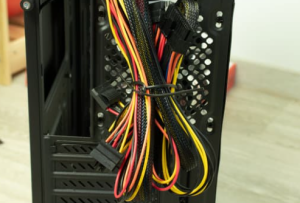
Proper PC cable management is crucial for several reasons. First and foremost, it improves airflow and cooling within the PC case, which is essential for preventing overheating and ensuring optimal performance. Neatly organized cables also make troubleshooting and maintenance much easier, as you can quickly identify and fix any issues that may arise. Additionally, a clean and organized cable layout enhances the aesthetics of your PC, giving it a more professional and polished look.
Furthermore, proper cable management reduces the risk of cable damage, such as snags or tangling, which can lead to hardware malfunctions or accidents. Last but not least, it increases the longevity of your cables by protecting them from wear and tear, ultimately reducing the need for frequent replacements. By investing time in good cable management, you can enjoy improved system performance, a more visually appealing setup, and enhanced durability of your components.
Understanding Power Supplies: Modular vs Semi-Modular
Modular power supplies offer customizable cable management, allowing you to use only the cables necessary for your PC setup. This flexibility helps reduce clutter and improves airflow within the PC case, essential for maintaining optimal performance. On the other hand, semi-modular power supplies have some permanently attached cables, which can limit your options for cable management.
Consider your needs and preferences when choosing between modular and semi-modular power supplies. A modular power supply may be the best choice if you value the ability to customize and optimize your cable routing. However, a semi-modular power supply might be more suitable if you prefer a simpler installation process or have a compact PC case with limited space.
Proper cable management ensures efficient and neat cable arrangement inside your PC. It not only improves airflow but also makes troubleshooting and maintenance easier. You can achieve good cable management in your PC setup by following a step-by-step guide and using cable ties, velcro straps, and cable combs.
What Makes a Case Suitable for Efficient Cable Management?
A case that offers ample space behind the motherboard tray for cable routing is ideal. Multiple cable management cutouts and grommets make it easier to route cables neatly. Removable or adjustable drive cages allow for better cable organization and airflow. Built-in features like Velcro straps or dedicated cable routing channels are highly recommended.
The Role of Velcro Cable Ties in PC Cable Management
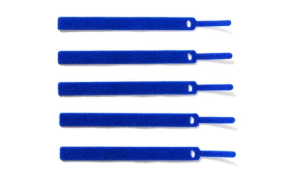
Velcro cable ties play a crucial role in PC cable management. A suitable case with ample space behind the motherboard tray is essential when organizing cables in a PC setup. It should also offer various cable management options like rubber grommets, cable routing holes, and Velcro straps or tie-down points.
One of the reasons why Velcro cable ties are popular is their adjustability and reusability. They allow you to bundle together cables of similar types or lengths, keeping them neat and organized. Moreover, Velcro ties can secure cables to the case or other components, preventing them from shifting or interfering with airflow. However, avoiding overtightening the ties is important to prevent cable damage or restricting airflow.
You can achieve a clean and efficient setup by incorporating these Velcro cable ties into your PC cable management strategy. So, whether you’re building a gaming PC or setting up a workstation, consider investing in Velcro cable ties for a hassle-free cable management experience.
Planning Your Cable Routing – The First Step
When planning your cable routing for your PC, the first step is to assess your PC components and determine the best cable management plan. This involves considering the location of your power supplies, motherboard, and other peripherals to ensure efficient cable organization. Once you have a plan, you can use zip ties, Velcro straps, or cable management clips to secure and organize your cables.
To achieve a cleaner look, it’s recommended to route your cables along the edges of the PC case and behind motherboard trays. This helps to hide the cables from view and improve the overall aesthetic of your setup. Additionally, cable combs or sleeves can bundle and neaten your cables, giving your PC a more professional finish.
As you go through the cable management process, it’s important to continually test your PC’s functionality to ensure all connections are secure. This will help prevent any issues that may arise from poorly managed cables. With proper planning and execution, you can achieve good cable management and improve your gaming PC’s overall airflow and performance.
How to Cable Manage a PC? – A Step-by-Step Guide
Step 1: Assess Your PC Components
Before you begin cable managing your PC, take a moment to assess your components. Look at the location of your power supplies, motherboard, graphics card, and other peripherals. Understanding the layout of your PC will help you determine the best cable management plan.
Step 2: Plan Your Cable Routes
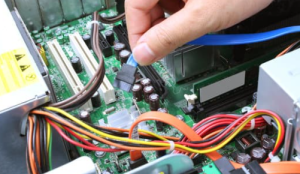
Once you have a clear picture of your PC’s layout, it’s time to plan your cable routes. Consider routing cables along the edges of the case and behind motherboard trays for a clean and organized look. This will also improve airflow within your system.
Step 3: Disconnect and Unplug
Before you start managing your cables, disconnect and unplug all power sources. This will prevent any potential accidents or damage to your PC components.
Step 4: Untangle and Straighten Cables
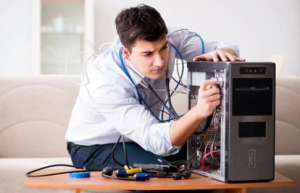
Next, untangle any twisted or tangled cables. Straighten them out as best as possible to ensure a clean and organized appearance. This will improve the overall aesthetics and make it easier to manage and route the cables.
Step 5: Use Cable Ties or Velcro Straps
Use cable ties or Velcro straps to group cables that serve a similar function, such as power, data, or audio. These handy tools will help keep your cables organized and prevent them from tangling or becoming a messy web of wires.
Step 6: Arrange Cables in a Logical Order
Once you have grouped your cables, it’s time to arrange them in a logical order. Consider the flow of your PC’s components and route the cables accordingly. For example, place power cables closer to the power supply and data cables near their respective devices.
Step 7: Secure Cables with Clips or Hooks To ensure that your cables stay in place, you can use clips or hooks to secure them. These accessories can be attached to the inside of your PC case or along the edges where you have routed the cables. This will prevent them from shifting around and help maintain a neat and organized cable management system.
Step 8: Use Cable Sleeves or Wraps
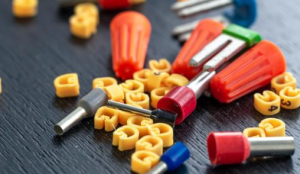
Consider using cable sleeves or wraps to take your cable management to the next level. These protective covers can enclose multiple cables, giving them a clean and streamlined appearance. Not only do they enhance the aesthetics of your PC, but they also provide an extra layer of protection against dust and potential damage.
Step 9: Label Your Cables
To make troubleshooting or future upgrades easier, it’s a good idea to label your cables. You can use color-coded tags or adhesive labels to identify the function of each cable. This will save you time and effort in the long run, especially when locating a specific cable quickly.
Step 10: Regular Maintenance
Finally, remember to check and maintain your cable management system regularly. Over time, cables may become loose or tangled again. Take a few minutes every few months to inspect your cables and make any necessary adjustments. This will ensure that your cable management system continues functioning properly and maintaining its neat appearance.
In addition to these steps, a few general tips and tricks can help with cable management. First, use cables of appropriate length for each connection, as excessive cable length can lead to unnecessary clutter. Second, consider using zip ties or Velcro straps to bundle together groups of cables that run parallel to each other. This will keep them organized and prevent them from tangling.
Managing External Cables – What Should You Know?
When managing external cables, there are a few key things to remember. Use cable ties or Velcro straps to bundle and organize the cables. Route them along the backside of your desk or behind furniture for a tidy appearance. Using cable clips or adhesive hooks, you can secure them to walls or surfaces. Consider using a cable management box or sleeve for a clean and organized look.
Conclusion
Proper cable management is crucial for maintaining the efficiency and longevity of your PC. It improves airflow, reduces heat buildup, and simplifies troubleshooting and upgrades. With a step-by-step guide on cable managing your PC, you can ensure a clean, organized setup that maximizes performance. From understanding power supplies to planning your cable routing, our comprehensive guide covers all aspects of PC cable management.
FAQ – How to Cable Manage a PC?
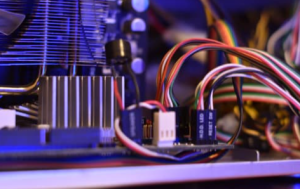
What is cable management PC?
Cable management in a PC involves organizing and tidying the cables inside the computer case. Using cable ties, clips, and sleeves, you can keep the cables neat and organized. This improves airflow, reduces clutter, and simplifies troubleshooting or upgrading components. Proper cable management also prevents cable damage and tangling, enhancing performance and aesthetics.
Should you cable manage PC?
Cable managing your PC is highly recommended. It improves airflow, reduces the risk of overheating, and makes troubleshooting and upgrades easier. There are various techniques and products available for effective cable management.
What cable do I need to transfer data from PC to PC?
You’ll need a USB or Ethernet cable to transfer data from PC to PC. A USB cable is the most convenient option if both PCs have USB ports. For faster speeds and network transfers, use an Ethernet cable. Choose the appropriate cable based on your specific needs and available ports.
Does cable management help airflow?
Proper cable management improves airflow in a PC by allowing better circulation through the case. This reduces heat buildup, prevents cables from obstructing fans or blocking air vents, and contributes to better cooling and system stability.
What are the benefits of sleeved cables?
Sleeved cables offer numerous advantages for PC cable management. They enhance the overall aesthetic of your build, improve cable organization, and reduce clutter, enhancing airflow and cooling within the PC case. Additionally, sleeved cables make identifying and troubleshooting any connection issues easier.
Do cable extensions affect PC performance?
Cable extensions don’t directly impact PC performance. However, poorly managed cables can obstruct airflow, leading to higher temperatures. Proper cable management improves airflow and helps maintain optimal performance. Use cable ties, Velcro straps, or cable combs to organize your cables.













